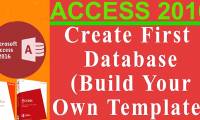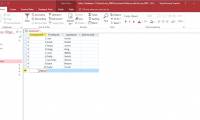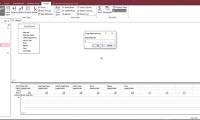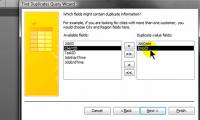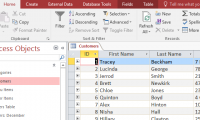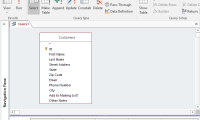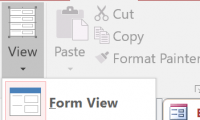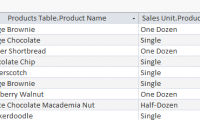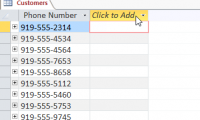
expressions in ms access can be understood similarly to formulas in excel. expressions can include operators, constants, functions, and identifiers.

in this article, tipsmake.com will work with you to learn the necessity of creating relationships between related tables. the relationship between tables is the data link between

in addition to the uses of the tipsmake.com query introduced in the previous lessons, you can also view data and records that meet two or more conditions using the alternative

the query criteria (query criteria) are filter conditions that help you retrieve specific items from an access database, used when you want to limit results based on values in a

creating a form for your database can make data entry more convenient. when you create a form, you can design it to match your database.

after creating the form, you may want to modify its interface. formatting a form can help make your database look consistent and professional. some format changes can even make

in this lesson, you will learn how to create a database from an existing template. you will also learn about other resources you can use to understand your own database design.

calculated fields and totals rows allow you to perform calculations from data in your tables.

parameter queries are one of the simplest and most useful queries you can create. because parameter queries are so simple, they can be easily updated to reflect the new search

duplicate search queries allow you to search and identify duplicate records in a table or multiple tables. duplicate records are a record that refers to the same or the same

microsoft access is a database creation and management tool. in order to understand access, you must first understand the database.

access database includes 4 objects: tables, queries, forms and reports. combining these 4 objects together can import, store, analyze and compile data the way you want.

if you have used access 2013 or 2010 you will be familiar with the access 2016 interface: ribbon ribbon and quick access toolbar (providing commands to perform common tasks in

in the previous lesson, you became familiar with the access 2016 interface as well as the opening and closing of the basic database. this article will continue to go deeper into

the query allows to retrieve information from one or more tables based on the search conditions you defined. in this lesson, you will learn how to create queries on a simple table

in this article, we will learn how to modify and sort queries in query design view, as well as how to use totals functions to create queries that can compute data. you will also

in this article, we'll learn how to create, edit, and print reports in access 2016 and how to use advanced reporting options.

in this lesson, you will learn how to create and rearrange fields in tables, how to ensure data is formatted correctly and consistently by setting validation rules, character
 expressions in ms access can be understood similarly to formulas in excel. expressions can include operators, constants, functions, and identifiers.
expressions in ms access can be understood similarly to formulas in excel. expressions can include operators, constants, functions, and identifiers. in this article, tipsmake.com will work with you to learn the necessity of creating relationships between related tables. the relationship between tables is the data link between
in this article, tipsmake.com will work with you to learn the necessity of creating relationships between related tables. the relationship between tables is the data link between in addition to the uses of the tipsmake.com query introduced in the previous lessons, you can also view data and records that meet two or more conditions using the alternative
in addition to the uses of the tipsmake.com query introduced in the previous lessons, you can also view data and records that meet two or more conditions using the alternative the query criteria (query criteria) are filter conditions that help you retrieve specific items from an access database, used when you want to limit results based on values in a
the query criteria (query criteria) are filter conditions that help you retrieve specific items from an access database, used when you want to limit results based on values in a creating a form for your database can make data entry more convenient. when you create a form, you can design it to match your database.
creating a form for your database can make data entry more convenient. when you create a form, you can design it to match your database. after creating the form, you may want to modify its interface. formatting a form can help make your database look consistent and professional. some format changes can even make
after creating the form, you may want to modify its interface. formatting a form can help make your database look consistent and professional. some format changes can even make in this lesson, you will learn how to create a database from an existing template. you will also learn about other resources you can use to understand your own database design.
in this lesson, you will learn how to create a database from an existing template. you will also learn about other resources you can use to understand your own database design. calculated fields and totals rows allow you to perform calculations from data in your tables.
calculated fields and totals rows allow you to perform calculations from data in your tables. parameter queries are one of the simplest and most useful queries you can create. because parameter queries are so simple, they can be easily updated to reflect the new search
parameter queries are one of the simplest and most useful queries you can create. because parameter queries are so simple, they can be easily updated to reflect the new search duplicate search queries allow you to search and identify duplicate records in a table or multiple tables. duplicate records are a record that refers to the same or the same
duplicate search queries allow you to search and identify duplicate records in a table or multiple tables. duplicate records are a record that refers to the same or the same microsoft access is a database creation and management tool. in order to understand access, you must first understand the database.
microsoft access is a database creation and management tool. in order to understand access, you must first understand the database. access database includes 4 objects: tables, queries, forms and reports. combining these 4 objects together can import, store, analyze and compile data the way you want.
access database includes 4 objects: tables, queries, forms and reports. combining these 4 objects together can import, store, analyze and compile data the way you want. if you have used access 2013 or 2010 you will be familiar with the access 2016 interface: ribbon ribbon and quick access toolbar (providing commands to perform common tasks in
if you have used access 2013 or 2010 you will be familiar with the access 2016 interface: ribbon ribbon and quick access toolbar (providing commands to perform common tasks in in the previous lesson, you became familiar with the access 2016 interface as well as the opening and closing of the basic database. this article will continue to go deeper into
in the previous lesson, you became familiar with the access 2016 interface as well as the opening and closing of the basic database. this article will continue to go deeper into the query allows to retrieve information from one or more tables based on the search conditions you defined. in this lesson, you will learn how to create queries on a simple table
the query allows to retrieve information from one or more tables based on the search conditions you defined. in this lesson, you will learn how to create queries on a simple table in this article, we will learn how to modify and sort queries in query design view, as well as how to use totals functions to create queries that can compute data. you will also
in this article, we will learn how to modify and sort queries in query design view, as well as how to use totals functions to create queries that can compute data. you will also in this article, we'll learn how to create, edit, and print reports in access 2016 and how to use advanced reporting options.
in this article, we'll learn how to create, edit, and print reports in access 2016 and how to use advanced reporting options. in this lesson, you will learn how to create and rearrange fields in tables, how to ensure data is formatted correctly and consistently by setting validation rules, character
in this lesson, you will learn how to create and rearrange fields in tables, how to ensure data is formatted correctly and consistently by setting validation rules, character





